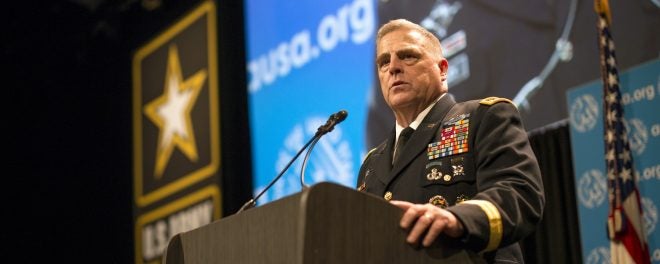The US Army’s new centralized procurement organization has been named: In his address at the Eisenhower Luncheon at the 2017 Association of the United States Army, US Army Chief of Staff General Mark Milley announced the creation of a Futures and Modernization Command (FMC), which would oversee the process of research, development, testing, evaluation, and procurement (RDTE&P) from start to finish. In his address, General Milley outlined a new process which would fundamentally change the current procurement model to a new one based on that used by US Special Operations Command:
You know, over time our competitive advantage has eroded. Our overmatch is being challenged in all domains. In our current system institutional organization our processes are no longer adequate for the task of modernization for an army of the future. So while commanders will prepare our force for today, we the institution must prepare our force for tomorrow. And we are at an inflection point in history as we must reform how we modernize our army – the roles, responsibilities, structures, organization. We have to address future readiness all across the board. And our institution that deals with modernization was fundamentally created four decades ago. Secretary McCarthy announced yesterday and again this morning and will discuss in some detail tomorrow a series of fundamental changes that we in uniform will embrace totally and we will implement quickly in order to prepare for the future. He has approved the concept of a new Modernization and Futures Command to consolidate the processes that inform and deliver Army capabilities and put them all under one roof. This is a significant change that will unfold over the next year and we will move quickly, because time is not on our side. The new command will be formed from existing structure and will combine elements of Army Futures, concept development, requirements and acquisition to ensure we remain the preeminent ground fighting force well into the future. Faster results will be obtained through significant streamlining of processes as we shift to a SOCOM-like model of buy-try-decide-and-acquire, rather than the current industrial age linear model that takes years to establish requirements, decades to test, and it may takes a long long time to go from idea to delivery. Our Army’s task in combat is to win, and we win by being on the offense, with the defense being only a temporary condition to set conditions to resume the offense. So each acquisition will be oriented to offense combined arms manuever in a dynamic, highly threatening, dense urban combat environment against a very capable enemy.
Milley’s full speech can be seen in the video embedded below, his comments on the Futures and Modernization Command can be heard starting at 44:34:
In a press conference the day prior, General Milley and acting Secretary of the Army Ryan McCarthy spoke more about the new command:
Secretary McCarthy explained that the new command would by prototyped through a task force led by Lt. General Edward Cardon, current director of the United States Army Office of Business Transformation. Neither General Milley nor Secretary McCarthy would comment about the fates of Army arms like RDECOM or ATEC, saying that would be determined by Lt. Gen. Cardon’s team.
It remains to be seen whether the new command will ease the malady that cripples US Army procurement, or just accelerate failures and monetary waste. It is certainly true that US Army’s procurement apparatus desperately needs reform, and Gen. Milley’s plan does seem sound enough to my decidedly non-expert ears. Experts I have spoken to have identified that the Army’s biggest problem is the physical diaspora of its RDTE&P arms, that is that they are physically separated by miles. In theory, General Milley’s new centralized command could alleviate this problem, but only time will tell.
 Your Privacy Choices
Your Privacy Choices
